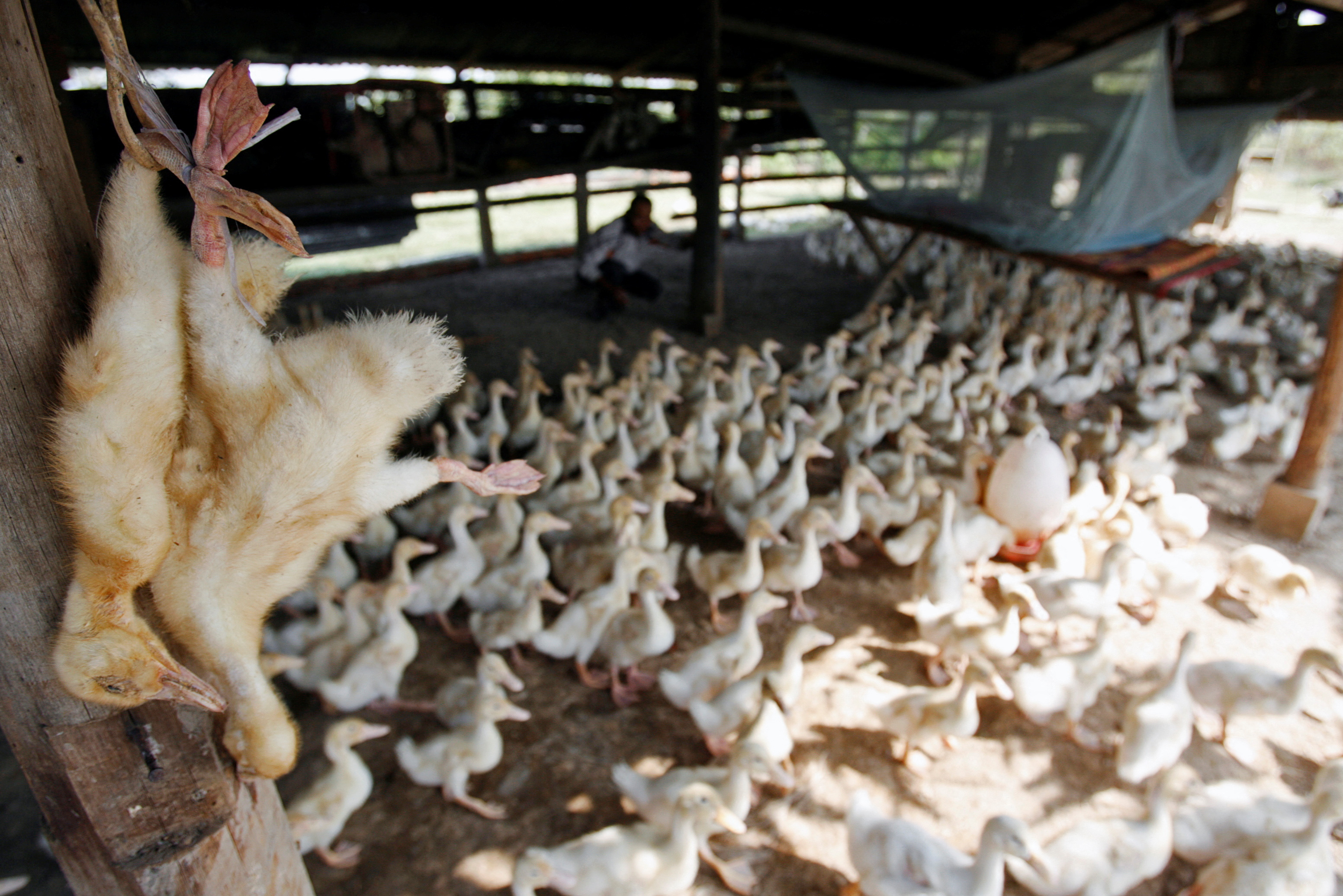Reuters

Dead ducks are hung at a farm in the outskirts of Phnom Penh
REUTERS/Chor Sokunthea
Feb 26 (Reuters) - The viruses that infected two people in Cambodia with H5N1 avian influenza have been identified as an endemic clade of bird flu circulating in the country, the U.S. Centers for Disease Control and Prevention (CDC) said.
The cases reported last week had raised concerns they were caused by a new strain of H5N1, clade 2.3.4.4b, which emerged in 2020 and has caused record numbers of deaths among wild birds and domestic poultry in recent months.
But work so far suggests this is not the case.
Preliminary genetic sequencing carried out in Cambodia led its health ministry to identify the viruses as H5 clade 2.3.2.1c, which has circulated in Cambodia among birds and poultry for many years and has sporadically caused infections in people, the CDC said in a statement on Saturday.
"Yes, this is an older clade of avian influenza that had been circulating around the region for a number of years and while it has caused human infections in the past, it has not been seen to cause human-to-human transmission. However, that doesn't mean that the threat is any less," said Erik Karlsson, director of the National Influenza Center of Cambodia and acting head of virology at the Institut Pasteur du Cambodge, which sequenced the virus.
He added that the response needed to be coordinated and swift to prevent any further spread and to limit exposure to any common source.
An investigation into the source and to detect any additional cases is ongoing, the CDC said, adding that so far there had been no indication of person-to-person spread.
Cambodia tested at least 12 people for the H5N1 strain last week, after an 11-year-old girl died from the virus in the first known transmission to humans in the country in nearly a decade.
The victim's father, who was part of a group the girl had been in contact with in a province east of the capital Phnom Penh, tested positive for the virus but did not exhibit any symptoms, Cambodia's Health Minister Mam Bunheng had said in a statement on Friday.
Only the girl's case has been sequenced and the father's case is still being worked on, Karlsson said.
The World Health Organization said it is working with Cambodian authorities following the cases, describing the situation as worrying due to the recent rise in cases in birds and mammals.
Register for free to Reuters and know the full storyRegister now
Reporting by Juby Babu in Bengaluru; additional reporting by Jennifer Rigby in London; editing by Barbara Lewis
Feb 26 (Reuters) - The viruses that infected two people in Cambodia with H5N1 avian influenza have been identified as an endemic clade of bird flu circulating in the country, the U.S. Centers for Disease Control and Prevention (CDC) said.
The cases reported last week had raised concerns they were caused by a new strain of H5N1, clade 2.3.4.4b, which emerged in 2020 and has caused record numbers of deaths among wild birds and domestic poultry in recent months.
But work so far suggests this is not the case.
Preliminary genetic sequencing carried out in Cambodia led its health ministry to identify the viruses as H5 clade 2.3.2.1c, which has circulated in Cambodia among birds and poultry for many years and has sporadically caused infections in people, the CDC said in a statement on Saturday.
"Yes, this is an older clade of avian influenza that had been circulating around the region for a number of years and while it has caused human infections in the past, it has not been seen to cause human-to-human transmission. However, that doesn't mean that the threat is any less," said Erik Karlsson, director of the National Influenza Center of Cambodia and acting head of virology at the Institut Pasteur du Cambodge, which sequenced the virus.
He added that the response needed to be coordinated and swift to prevent any further spread and to limit exposure to any common source.
An investigation into the source and to detect any additional cases is ongoing, the CDC said, adding that so far there had been no indication of person-to-person spread.
Cambodia tested at least 12 people for the H5N1 strain last week, after an 11-year-old girl died from the virus in the first known transmission to humans in the country in nearly a decade.
The victim's father, who was part of a group the girl had been in contact with in a province east of the capital Phnom Penh, tested positive for the virus but did not exhibit any symptoms, Cambodia's Health Minister Mam Bunheng had said in a statement on Friday.
Only the girl's case has been sequenced and the father's case is still being worked on, Karlsson said.
The World Health Organization said it is working with Cambodian authorities following the cases, describing the situation as worrying due to the recent rise in cases in birds and mammals.
Register for free to Reuters and know the full storyRegister now
Reporting by Juby Babu in Bengaluru; additional reporting by Jennifer Rigby in London; editing by Barbara Lewis
No comments:
Post a Comment